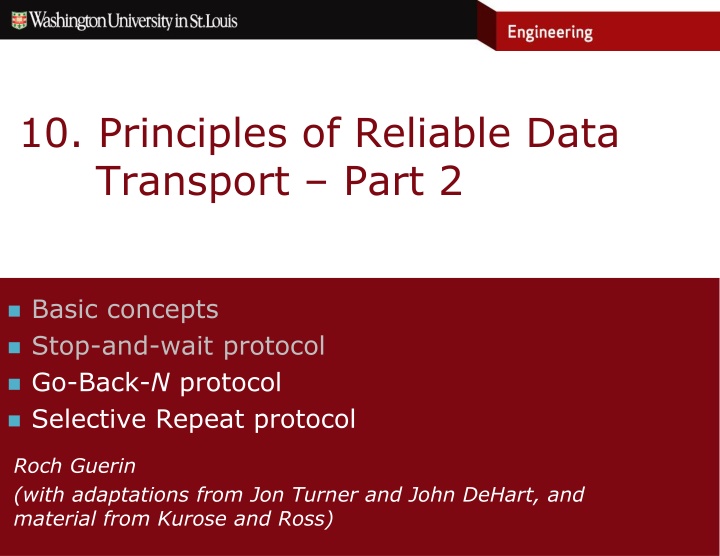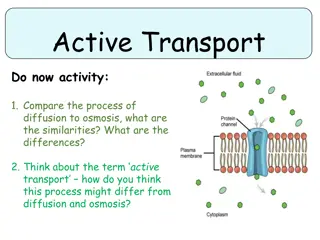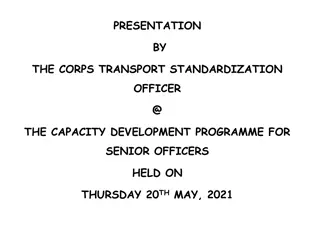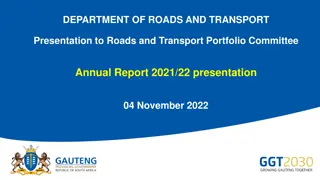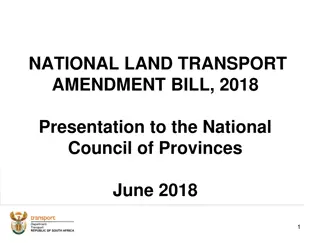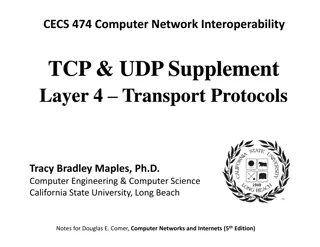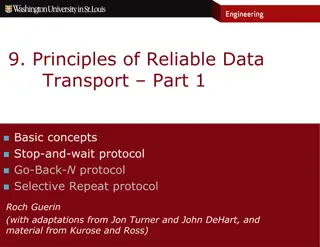10. Principles of Reliable Data Transport
Learn about reliable data transport protocols such as Stop-and-Wait, Go-Back-N, and Selective Repeat. Understand the operational principles, sender and receiver variables, buffering, packet numbering, and more. Enhance your knowledge of how these protocols ensure non-stop data transmission and efficient operation in networking scenarios.
Download Presentation

Please find below an Image/Link to download the presentation.
The content on the website is provided AS IS for your information and personal use only. It may not be sold, licensed, or shared on other websites without obtaining consent from the author.If you encounter any issues during the download, it is possible that the publisher has removed the file from their server.
You are allowed to download the files provided on this website for personal or commercial use, subject to the condition that they are used lawfully. All files are the property of their respective owners.
The content on the website is provided AS IS for your information and personal use only. It may not be sold, licensed, or shared on other websites without obtaining consent from the author.
E N D
Presentation Transcript
10. Principles of Reliable Data Transport Part 2 Basic concepts Stop-and-wait protocol Go-Back-N protocol Selective Repeat protocol Roch Guerin (with adaptations from Jon Turner and John DeHart, and material from Kurose and Ross)
Improving RDT 3.0 Basic goal is to be able to transmit non-stop under normal (no errors) operation first ack must arrive before the sender finishes transmission of Nthpacket To enable more efficient operation, we want a protocol that can keep transmitting while waiting for acks, i.e., one that pipelines transmissions sender can transmit up to N packets while waiting for acks each packet labeled with sequence # from set of S>N sequence #s receiver sends acks with sequence numbers Two major variants go-back-N (cumulative ack)and selective repeat (specific ack) 2
Go-back-N with N=4 lost packet selective repeat lost packet go-back normal case P0 P0 P1 P2 P3 P0 P1 P2 P3 P1 P2 P3 timeout timeout A0 A0 A0 A1 A2 A3 A0 A0 A2 A3 P1 P1 P2 P3 A1 A1 A2 A3 3
Go-Back-N Operation Sender variables Send window size: SWS=N Last pkt sent: LPS Last ack received: LAR Receiver variables Receive window size: RWS (= 1) Last pkt received: LPR Latest acceptable pkt: LAP Allow pkt transmissions as long as LPS-LAR SWS If LPS-LAR SWS, send next pkt with SN = LPS+1 ACK for pkt number X>LAR updates LAR to X (slides the window) Note that X LAR+1 is OK (cumulative ACKs acknowledge all pkts up to X) Need: LAP-LPR RWS i.e., LAP = RWS +LPR (RWS=1 only one acceptable pkt) When pkt SN arrives (with RWS=1) If SN !=LPR+1, discard pkt Only accepts packets in order Else accept pkt and setLPR = SN Send (cumulative) ACK for LPR It is a cumulative ACK but it is always just 1 more than last ACK sent! 4
Go-Back-N Sender & Receiver SENDER SWS LAR LPS LPS - LAR SWS RECEIVER RWS LAP LPR LAP- LPR RWS LAR: Last Ack Received, LPS: Last Packet Sent, SWS=N: Send Window Size LPR: Last Packet Received, LAP: Latest Acceptable Packet, RWS: Receive Window Size 5
Buffering & Numbering Packets Sender How big should S be? Obviously) S SWS Suppose S=4 (Seq. Num. field {0, ,3}) and SWS =4 Sender transmit frames 0, ,3 Arrive successfully, but all ACKs are lost Sender retransmits 0, ,3 (after timeout) Receiver expects new 0, ,3, gets second incarnation of old0, ,3, incorrectly accepts as new In general, we need S RWS + SWS 0 1 7 copies of unacked packets 2 6 3 5 4 ready to send 4 Protocol uses sequence numbers 0 S 1=2m-1 Re-use sequence numbers in circular fashion all sequence number arithmetic is modulo S Window size SWSspecifies number of pkts that can be unacknowledged 6
Go-Back-N State Machines Receiver (start in state 0) receive packet i deliver packet and send ack i receive packet k i send ack i 1mod S state i state i+1 mod S expecting packet i mod S Sender (start in (0,0)) packet available and j i<SWS send packet j, save copy, start timer state (i,j+1) receive ack k state (i,j) if k in i..j 1 discard packet copies i..k, for k j stop timers timeout resend packets i..j 1, restart timers state (k+1,j) oldest unacked packet is i, next packet to send gets seq#j 7
Go-Back-N Performance Performance depends on Time-out value (timer starts when last bit of packet is sent) Assume tout= ( - 1)tpkt RTT As RTT increases, toutwould increase tpkt : transmission time of packet Value of window size N Assume N is large enough to keep the pipe full in the absence of losses, i.e., (N 1)tpkt > RTT Impact and frequency of retransmissions Expected Time for a Successful Packet Transmission: Tsucc We need to know: Time for the initial transmission: tpkt Expected number of retransmissions: E[R] Time for a single retransmission: Tr Tsucc = E[R] Tr + tpkt 8
Go-Back-N Performance Let Trbe the time spent for one retransmission Tr= tpkt + tout = tpkt Time spent per packet: T = RTr + tpkt Ris number of retransmissions (geometrically distributed) E[R]=q/(1-q), where qis the pkt loss probability Expected time for successful packet transmission Tsucc= E(R)Tr+tpkt=1+(a -1)q tpkt 1-q Next pages show how we get to the above equation 100% throughput if tpkt = Tsucc Achievable when q=0 (no pkt or ACK losses) For a given value of q, throughput decreases as , i.e., RTT, increases 9
Retransmissions as a Geometrically Distributed Random Variable Packet loss probability: q (we can ignore ack losses) R retransmissions means that packet transmissions fail R times before succeeding P(R retransmissions) = qR(1 q) E[R] = {R=0 to }RqR(1 q) = q(1 q) {R=0 to }RqR-1 = q(1 q)/(1 q)2 =q/(1 q) So a successful transmission requires one original transmission plus R retransmissions, for a total time of tpkt + R (tout + tpkt), or on average tpkt + tpkt x q/(1 q) = tpktx(1 + ( 1)q)/(1 q) 10
Go-Back-N Performance (continued) Derivation of Tsucc Tsucc = E[R] Ttotal + tpkt E[R] = q/(1-q) and Ttotal = tpkt Tsucc = (q/(1-q)) tpkt + tpkt Tsucc = (q/(1-q)) tpkt + tpkt (1-q)/(1-q) Tsucc = (q tpkt /(1-q)) + (tpkt - qtpkt )/(1-q) Tsucc = (q tpkt + tpkt - qtpkt )/(1-q) Tsucc = tpkt (q + 1 - q)/(1-q) Tsucc = (1 + ( - 1)q) tpkt /(1-q) + 1 ( ) 1 q = + = ( total T ) T E R t t succ pkt pkt 1 q 11
Receive Buffer in Selective Repeat waiting for packet 1 0 1 7 2 6 3 5 4 Receiver maintains buffer of up to RWS=SWS=N packets On receiving packet i, send ack i If arriving packet is in window range and no previous copy is in buffer, store new packet If arriving packet is next one expected deliver it and all other packets up until the first hole in buffer advance window to location of first hole Correct operation calls for in-order packet delivery and S 2N (S is the number of sequence numbers) Why? 12
Selective Repeat State Machines Receiver (start in state 0) receive packet i send ack i, let jbe index of first hole , deliver packets i..j 1 receive packet k i send ack k, if k in i..i+W 1 and no copy of k in buffer, store k in buffer state i state j expecting packet i Sender (start in (0,0)) packet available and j i<W send packet j, save copy, start timer Tj state (i,j+1) receive ack k not in i..j 1 do nothing receive ack k in i..j 1 discard packet k,clear timer Tk, let i be seq# of oldest unacked packet, or j state (i,j) timer Tk times out resend packet k, restart Tk oldest unacked packet is i, next packet to send gets seq# j state (i ,j) 13
Exercises 1. Draw a time-space diagram for the go-back-N protocol with N=3, S=6, assuming that five packets are sent, and the second and fifth packets are lost the first time they are sent. Show the states of the sender and receiver. 14
Go-back-N with N=3, S=6 1. Draw a time-space diagram for the go-back-N protocol with N=3, S=6, assuming that five packets are sent, and the second and fifth packets are lost the first time they are sent. Show the states of the sender and receiver. Sender: (ack-waiting, nxt_pkt) Receiver: (expecting_pkt) Sender state starts at (0,0) and eventually ends at (5,5) when ack for P4 is received. Receiver state starts at 0 and ends at 5 (0,0) (0,1) 0 P0 P1 P2 (0,2) (0,3) timeout A0 1 A0 (1,4) P3 P1 P2 P3 2 3 A0 A1 A2 A3 (1,4) (2,5) (3,5) (4,5) timeout P4 4 P4 A4 5 (5,5) 15
Exercises 2. Consider a link that uses go-back-N with S=10, N=5. Suppose 4 packets have been sent and 2 acks have been received. What is the smallest possible number of packets that could still be in the send buffer? What is the largest number? 16
Exercises 2. Consider a link that uses go-back-N with S=10, N=5. Suppose 4 packets have been sent and 2 acks have been received. What is the smallest possible number of packets that could still be in the send buffer? What is the largest number? Consider a scenario, where the first and second packets are lost. This will trigger ACKs when the third and fourth packets arrive, acknowledging receipt of the packet before the first (or the SYN packet). Under such a scenario, the two acks will not be for any of the four packets that have been sent, so that the sender will still have all four in its send buffer. In the best case, the two acks are for the 3rd and 4th packets and there are zero packets left in the send buffer (acks for packets 1 and 2 were lost). 17
Exercises 3. Draw a time-space diagram for the selective repeat protocol with N=3, S=6, assuming that five packets are sent, and the second and fifth packets are lost the first time they are sent. Show when each packet is delivered and the states of the sender and receiver at each step. 18
(0,1) (0,2) Selective Repeat with N=3, S=6 P0 P1 P2 0 0 (0,3) timeout A0 A2 3. Draw a time-space diagram for the selective repeat protocol with N=3, S=6, assuming that five packets are sent, and the second and fifth packets are lost the first time they are sent. Show when each packet is delivered and the states of the sender and receiver at each step. 1 P3 P1 (1,4) 1,2,3 4 A3 A1 (4,5) P4 4 timeout State starts at (0,0) and eventually ends at (5,5) when ack for P4 is received P4 4 19 5
Exercises 4. Consider a link that uses selective repeat with S=10, N=5. Suppose 4 packets have been sent and 2 acks have been received. What is the smallest possible number of packets that could still be in the send buffer? What is the largest number? 20
Exercises 4. Consider a link that uses selective repeat with S=10, N=5. Suppose 4 packets have been sent and 2 acks have been received. What is the smallest possible number of packets that could still be in the send buffer? What is the largest number? With selective repeat, packets are acked individually. So in all cases, the receipt of two ACKs identifies two packets (out of four) that have been received. Hence, there will then be two packets in the sender s send buffer (even if all four packets were successfully received). Note that in practice, selective acknowledgments are used in combination with cumulative ACKs, e.g., through the use of a SACK option as in TCP (see RFC 2018). This helps overcome the fragility problem caused by requiring that each packet be individually acked. In particular, TCP s SACK option allows the receiver to inform the sender of multiple (up to 4) non-contiguous blocks of data it received. It is used in combination with regular ACKs. 21
